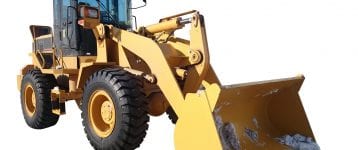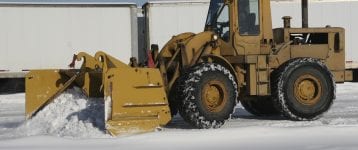Heavy snow is a liability for business owners and something you should have a professional handle
Wintertime isn’t just a season when people pack on a few extra pounds. Mother Nature does it too in the form of heavy snow. Snow slows traffic, closes schools, and can cause quite a bit of chaos, but you’d be forgiven for thinking the fluffy white stuff doesn’t weigh that much.
Anyone shoveling a driveway knows the truth: Snow comes in several densities and deposit speeds. Given enough time, any one of these can lead to dangerously heavy loads on commercial properties, which is especially dangerous to flat-roofed businesses. Here’s how snow gathers weight and the damage it can cause if it’s left for too long.
The Rough Weight of Snow
The weight of snow isn’t an exact science due to several factors, but in general it weighs approximately 20 pounds per cubic foot or 1.25 pounds per inch of depth. The moisture content of the snow ultimately decides how heavy the flakes are going to be, with the fluffier snow being the least moisture dense.
Snow weight works inversely with the outside temperature. Colder weather contributes to lighter snowflakes because the snow tends to be drier. A warmer winter creates heavier and more dangerous flakes. Strange but true: the warmer it is, the greater the risk of roof-damaging snow. Don’t be fooled that one is worse than the other, however.
Snow removal at ground level can be a Herculean task, but even fluffy snow is a serious threat. Three feet of fluffy snow on a commercial roof measuring 28×40 feet would create 12 tons of weight. If we factor that figure upward to account for heavier snow, the weight jumps to 33 tons on the same roof.
It’s just as heavy if businesses are facing blocked doorways, sidewalks, or parking lots. Imagine 33 tons piled in front of your commercial property, slowing down business operations and potentially injuring staff or customers.
But wait — snow can get even heavier. Snow is always more than “just snow” because it has the potential to compact into ice or thaw into freezing water, which still adds some weight of its own. Iced or liquidized snow each add around 5.2lbs for every 1 inch of depth.
Businesses with sloped roofs might have a better chance of liquid or snow sliding off and relieving some of that weight. At the same time, sloped roofs have the added risk of forming ice dams; blockages that keep water and snow trapped on a roof.
Clearing snow even at ground level can seem like an impossible task without professional help, and it’s only harder to clear a roof — especially a flat roof that’s in the most danger from heavy snow.
Why Flat Roofs Are at Greater Risk from Snow
The term “flat roof” isn’t strictly accurate. Roofs with less than a 3/12 pitch are classified as being flat because such a gentle slope, or the total absence of one, means there’s little chance of snow going anywhere.
Once snow settles, it quickly becomes a static burden that can cause flat roofs to bow (picture the sagging of a taut blanket with a rock in the middle). Continuously falling snow will continue to deposit weight on that bowed spot until it gives out and ruptures.
Thermal expansion and extraction, more commonly called the freeze/thaw cycle, further contributes to snow damage at ground and roof level. Settled snow can do just as much harm to a parking lot when the melting water starts to pond. The ice or water formed by this cycle puts serious pressure on the surface and tear open cracks that can cause leaks. These openings quickly worsen, compromising the integrity of commercial paving, which endangers both pedestrians and vehicles.
It’s understandable that business owners would want to keep their premises clear of snow themselves, but the best intentions can worsen the problem and put the safety of both the building and its occupants at greater risk.
Improper Snow Clearance Can Cause More Trouble
Snow rakes and common removal methods, such as rock salt, can do more harm than good. Overly zealous raking can tear or diminish roofing and paving materials, which only makes it easier for snow and leaks to do their worst. Rock salt and other chemicals like calcium chloride may do a good job of melting the snow, but their abrasiveness also does a number of properties and parking spaces.
Snow removal is a job for professionals who have the experience and equipment to protect your business property, its occupants, and themselves. The costs of repairing a roof collapse or worse — like medical expenses for back injuries and broken bones from slips and falls — are far more damaging to a business’ bottom line than hiring a professional to do the job.
We recommend speaking to a roofing professional for safe snow removal upstairs, and we have over 70 years of professional experience here at Mikula Contracting. We’re fully insured and can handle even the heaviest snow removal jobs on a one-time or ongoing basis.
Mikula Contracting, Inc. provides commercial and residential customers with a wide range of excavation, demolition, environmental, snow removal, trucking, and soil maintenance services. For more information, call 973-772-1684 or email info@mikulainc.com



